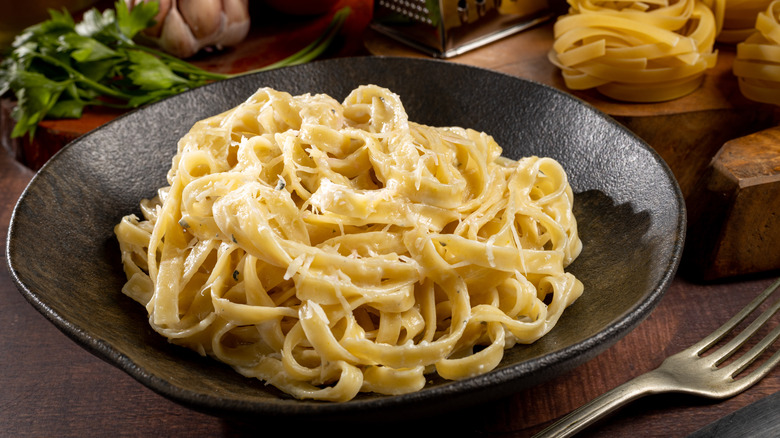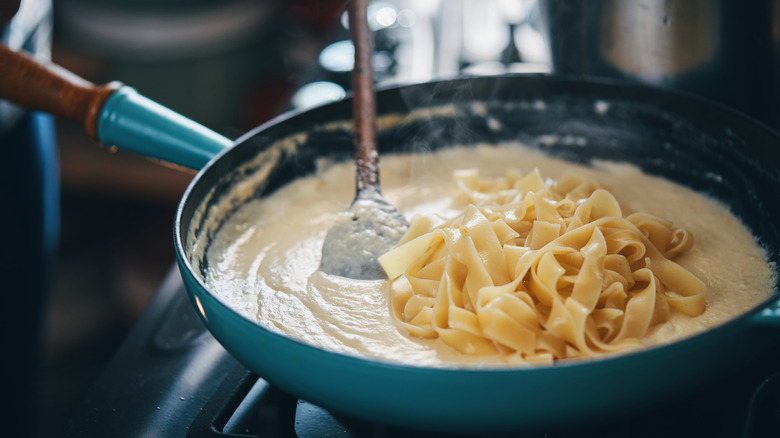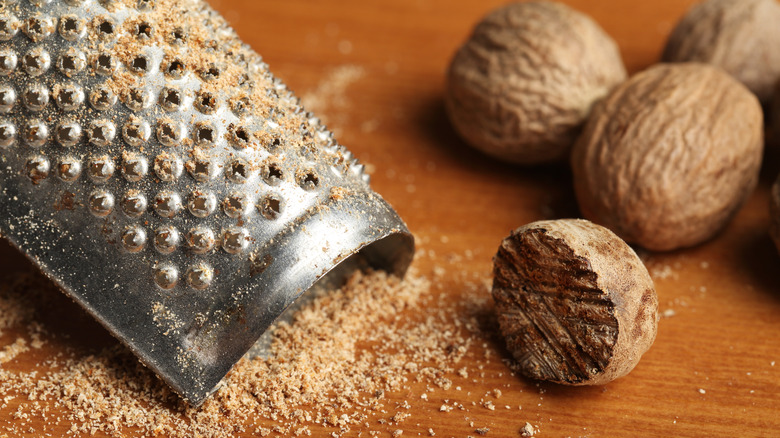Improve Store-Bought Alfredo Sauce With One Staple Seasoning
There is absolutely nothing wrong with using store-bought sauces. Many are well made, and they help speed up dinner, particularly on a busy weeknight. But often, something seems to be missing. That's when adding a key ingredient can make all the difference. For example, Giada De Laurentiis likes to add chunks of Parmesan rind to most of her sauces. When it comes to creamy Alfredo sauce, there is usually enough cheese already, but one seasoning in particular can add a refreshing and surprising new flavor note: nutmeg.
That's right, the baking spice more commonly associated with pumpkin spice lattes is a bit of a secret weapon when it comes to elevating a jar or plastic tub of Alfredo sauce. It doesn't even take much — just a few dashes per serving — to elevate the store-bought sauce to new heights. Sure, it might not pass muster with fans of traditional Italian cooking, but hey, we put sausage on our pizzas and sip our espressos. What's a little out-of-season holiday spirit among gustatory friends?
Traditional vs store-bought Alfredo sauce
Italians are rightfully proud of their authentic regional dishes and recipes and sometimes scoff at modern interpretations. Alfredo sauce is particularly interesting, since what you buy at the grocery store bears little resemblance to what dresses Italian fettuccine Alfredo (the pasta dish that bears the original name).
Developed in the late 19th century as a tweak on traditional fettuccine al burro ("with butter"), the dish consists of fresh fettuccine mixed with butter and fresh Parmesan cheese and is actually considered to not have a sauce (in bianco, or blank). The combo acquired the name Alfredo around 1908 when a restaurant worker in Rome, Alfredo Di Lelio, crafted his version for his postnatal wife, then later made the dish at his eponymous restaurant.
In contrast, the Alfredo sauce you find on store shelves in the United States often contains additional ingredients, including milk, heavy cream, often a bit of garlic, and a smattering of seasonings. Olive Garden has been making it this way since 1982, and it's delicious, if not traditional. In some ways, it's closer to a basic French béchamel sauce. Nutmeg is a common ingredient in béchamel, bringing a little warmth, sweet-spicy complexity, and depth to what is otherwise essentially flour, milk, and butter. With that in mind, adding nutmeg to Alfredo sauce begins to make sense.
When to add nutmeg to Alfredo sauce
It helps to add a little something to most store-bought Alfredo sauces anyway. They vary quite a bit in consistency, additional ingredients, and viscosity. If the sauce is too thick and gloopy, add chicken stock or wine. It can also help to blend in more pepper or garlic. Some store-bought versions even contain a little agave nectar to play up the sweetness.
What you likely won't find in ready-made sauces is nutmeg. After trying it, though, you may wonder why not. It's worth running a little taste test. Just heat up some jarred sauce (don't let it burn) and pour it over a serving of pasta. A decent Alfredo is creamy without being bland, and just a tad buttery. It should make you want another bite immediately.
Add the nutmeg during or right after heating, and mix well. A little goes a long way: Consider a dash or two for a single serving, or about a quarter teaspoon for a serving of four to six. Both pre-grated (powdered) and fresh-grated nutmeg work, but in the case of a buttery Alfredo, it seems the powdered version brings a bit more flavor, while the fresh nutmeg is aroma-forward. The end result is a new look for a modern classic. The nutmeg brings a hint of earthy, zesty bite, a little more complexity, and a deep aromatic note to the dish. It's possible Sunday pasta nights will never be the same!


